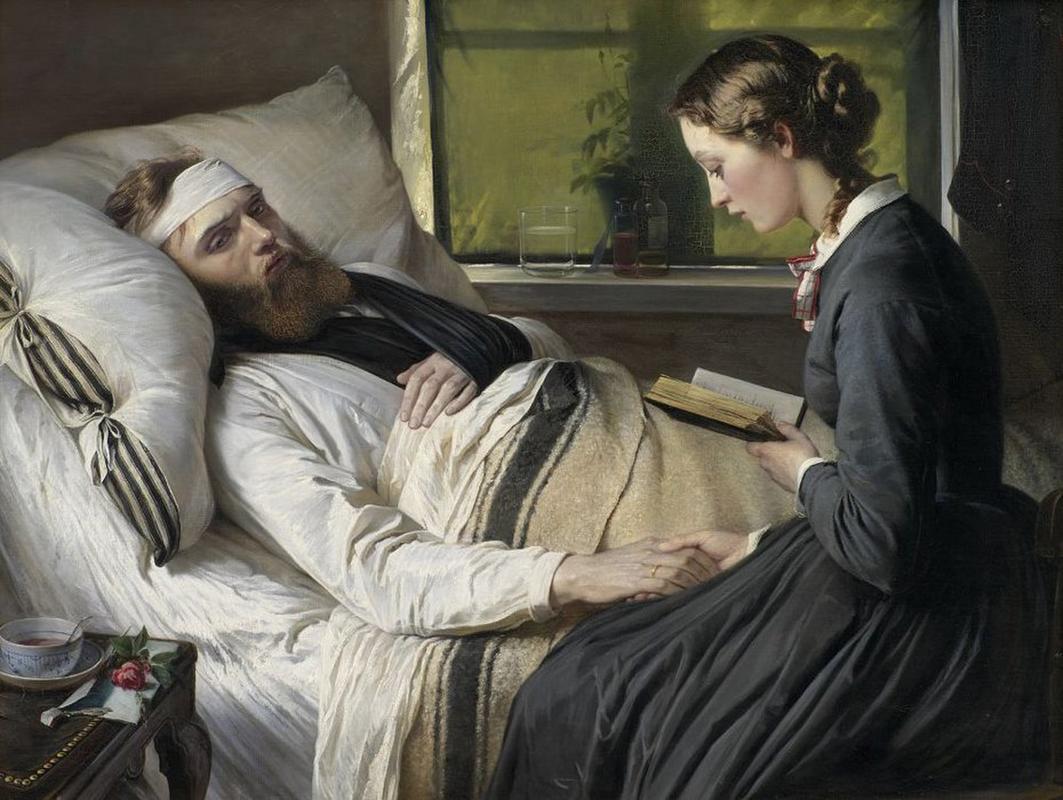More about A Wounded Danish Soldier

Contributor
Like Ole Peter Hansen Balling and former "Caleefonya gavna" Arnold Schwarzenegger, Elisabeth Jerichau-Baumann knew how to sing the praises of her adopted national identity, as she does in A Wounded Danish Soldier.
It's no mere coincidence, then, that after overlooking her masterpieces for as long as possible, the Statens Museum for Kunst, the Danish government art museum, finally decided to invest in Baumann by buying A Wounded Danish Soldier in 1867. It helped that the purchase came hot on the heels of the latest Danish military campaign, a squabble called the Second Schleswig War, emerging from the esoteric "Schleswig-Holstein Question," a dispute the technical details of which are less accessible than quantum physics. The British Lord Palmerston, according to an account published by the marchese della Marmora in Firenze, eight years after Baumann released this work, joked that only three people ever understood the thing: Queen Victoria's late husband, the Prince Consort, a Danish bureaucrat who went mad, and Palmerston himself.
Of course, as with many wars, the immediate causes were land, strategic position, and material resources. Remembering the Schleswig-Holstein Question might be a good way of understanding how the Germans decided to declare war on almost everybody less than a century later. The Schleswig-Holstein Question wouldn't resolve itself until after WWI, when Germany was in big trouble. They split Schleswig, and the families of Schleswig, in two along a north-south border. Of course, there's still a minority Danish population in South Schleswig and a German minority in North Schleswig.
Baumann was born in Poland, as Birgit Pouplier reminds us in her excellent biography Lisinka, which takes its title from Baumann's cute nickname. However, ironically, Baumann's parents belonged to the very people who were the bitter enemies of the Danish: the Germans. We can assume from its provenance and original title that A Wounded Danish Soldier was like Guernica, in that it was making an essentially pacifist statement about the universal crimes of war. Baumann's work aims to recount the life of her adopted country without forgetting the horror of war, as in the rough and rowdy war poetry of the German realist novelist Theodor Fontane (1819-1898), who protested the rising militarism in Prussia and wrote this about the Second Schleswig War:
Six columns—ain't that a kick [in the butt]?...
Three hundred men gambling with their lives in the mud
A bullet hits, the mud splashes
All three hundred fall silent
Danish nationalism could be implied by the original title of Baumann's work, which, instead of "soldier" (soldat), opts for kriger, meaning "fighter" or "warrior." In 1904, however, the author Clara Erskine Clement Waters evoked a more sweetly domestic scene by calling the work by this name: A Wounded Soldier Nursed by his Betrothed.
Sources
- Been, Charles Arnold. Danmarks Malerkunst, Bind 1. Købnhavn: Det Nordiske Forlag, 1902.
- Fabritius, Elisabeth. The Ambassador John L. Loeb Jr. Danish Art Collection. New York: J. L. Loeb, 2005.
- della Marmora, the marchese Alfonso Ferrero. Un po' più di luce sugli eventi politici e militari dell' anno 1866, Volume 1. Firenze: G. Barbéra, editore, 1873.
- Pouplier, Birgit. Lisinka. Copenhagen: Lindhardt og Ringhof, 2016.
- Schurdel, Harry D. "Piefke macht Geschichte(n)." SHZ.de, Apr. 13, 2014, https://www.shz.de/regionales/schleswig-holstein/kultur/piefke-macht-ge…“,Entscheidungsschlacht%20des%20Deutsch-Dänischen%20Krieges.
- Waters, Clara Erskine Clement. Women in the Fine Arts: From the Seventh Century B. C. to the Twentieth Century A. D. New York: Houghton, Mifflin, 1904.
- Weilbach, Philip. Dansk Konstnerlexikon, indeholdende korte Levnedstegnelser over Konstnefe, som indtil Udgangen af 1876 have levet ... i Danmark eller den danske Stat. Kjøbenhavn: Höst og Sön, 1877.











